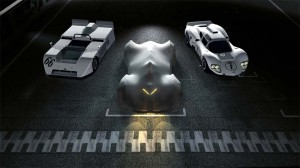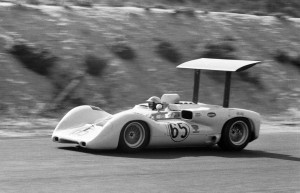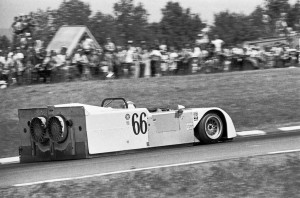
Chevrolet developed a modern interpretation of the Chaparral cars for GranTurismo's 15th anniversary.
Every so often, a race car comes along that fundamentally transforms the world of motor sports, and there are few better examples that the exotic Chaparrals raced by Jim Hall and Hap Sharp back in the early 1960s.
It’s hard to imagine a Formula One racer or an IndyCar today without their pioneering work on aerodynamics – the ground effects, the wings, and spoilers integrated into models as groundbreaking as the Chaparral 2D and the 2J CanAm “sucker car.”
Despite winning the 1980 Indianapolis 500, the partners left racing two years later. But what might have happened if they continued in the sport? What would a Chaparral look like today? That’s something Chevrolet is exploring with the Chaparral 2X VGT concept it will reveal at the upcoming Los Angeles Auto Show.
The project was kicked off to help celebrate the 15th anniversary of the PlayStation racing game, Gran Turismo, which asked automakers to look into the future of automotive design. Chevy’s decision to tinker with the Chaparral was not entirely a surprise, as the maker provided engines for the Hall and Sharp team.

The Chaparral 2E changed motor sports in the 1960s and is the inspiration for Chevrolet's newest concept.
“Jim Hall and Chaparral blended the art of racing with science in an unprecedented way, changing the sport forever and inspiring a new generation to experiment with aerodynamics and unconventional materials,” said Mark Reuss, General Motors’ director of Global Product Development, Purchasing and Supply Chain. “His race cars were four-wheeled physics projects that proved innovation – and a strong Chevy race engine – could drive you to the winner’s circle.”
The original Chaparral was actually a relatively conventional, front-engine race car developed by Dick Troutman and Tom Barnes in 1961. Hall and Sharp came along a year later and acquired the rights to the name – but their Chaparral 2 was a very different beast, with a mid-engine layout framed by an aerospace-style semi-monocoque chassis of fiberglass. It used a 327-cubic-inch Chevy small block V-8 and later adopted an unusual torque-converter transaxle.
The Chaparral 2 instantly made itself a force to be reckoned with, taking pole position in its very first race, at California’s Riverside, in 1963. Hall drove it a United States Road Racing Championships in 1964. And it upended the traditional international teams with a victory at the 12-hours of Sebring in 1965.
The Chaparral team continued to innovate with cars like the high-winged 2E that dominated the Can-Am series in 1966, and the 2F that followed a year later – Chevy bragging that its research operations helped develop some of the team’s more innovative aerodynamic features.
(General Motors laying off 510 workers. For more, Click Here.)
Perhaps the most radical design emerged in 1970 with the debut of the Chaparral 2J. The “sucker car” relied on a big-block Chevy V-8 for primary motivation, but it also had a separate motor that drove twin fans that literally vacuumed the car down onto the pavement. It allowed the Chaparral to launch through corners at seemingly impossible speed – though the approach also could be dangerous if suction was lost.
After nabbing three pole position starts in its first four races, the controversial sucker car was outlawed.
(Click Here for details about automakers creating rules for data privacy.)
Johnny Rutherford piloted the final Chaparral car, the 2K, to a victory at Indy in 1980, nabbing four other wins that season.
(To get a look at a spy shot of the 2016 Ford Mustang Shelby 350GT, Click Here.)
While the Chaparral team retired in 1982, Hall returned to racing in the 1990s, retiring for good after the 1996 season, despite some new success.
The surviving Chaparral cars are now on display at the Permian Basin Petroleum Museum in Midland, Texas, where local native Hall made the big fortune he turned into a small one – as the old adage goes – in racing.


I love the article. I loved the early Chaparral cars, I saw them race at Elkhart Lake in the mid-sixties, and a salute Chevy for their acknowledgement of this fine association.
Having said that, the modern interpretation of the Chaparral cars that Chevy developed for Gran Turismo’s 15 Anniversary looks exactly like a rotisserie chicken at my local food store! Is that really the best they could do?
Sorry guys, I am a big Chaparral fan and I am crushed.
Glad to see the author understands the difference between an engine and a motor. The “unusual” trans axle was the result of putting a torgue converter on a manual gearbox.